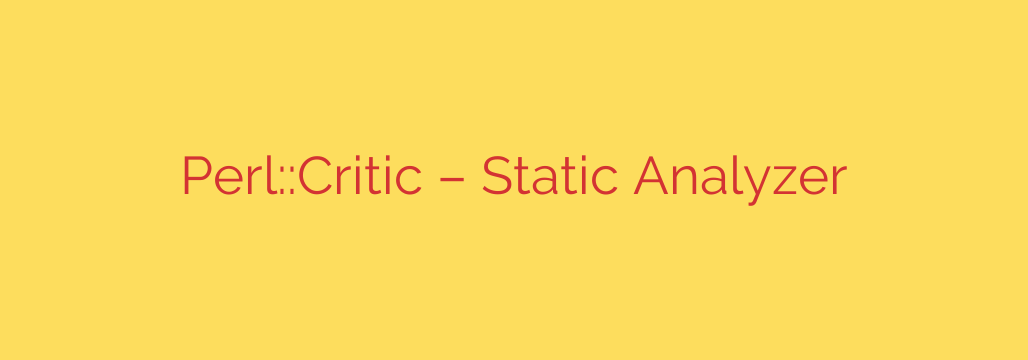
Mastering Perl Code Quality: A Deep Dive into Perl::Critic
In the world of software development, writing code that simply works is only the first step. Creating code that is clean, maintainable, and robust is what separates good developers from great ones. For Perl programmers, one of the most powerful tools for achieving this level of quality is Perl::Critic, a static code analysis engine designed to help you write better, more professional code.
Static analysis is the process of examining source code without actually executing it. This allows tools to identify potential bugs, stylistic errors, and deviations from best practices long before the code ever reaches a production environment. By integrating this practice into your workflow, you can catch issues early, enforce consistency across teams, and significantly improve the long-term health of your codebase.
What is Perl::Critic and How Does It Work?
Perl::Critic is a highly extensible framework for creating and applying coding standards to Perl source code. It is heavily inspired by the principles laid out in Damian Conway’s renowned book, Perl Best Practices. Think of it as an automated, tireless code reviewer that meticulously checks your work against a comprehensive set of rules.
The core of Perl::Critic is its system of “Policies.” Each policy is a specific rule that checks for a single good practice or a common mistake. These policies cover a vast range of topics, including:
- Code Layout: Issues like whitespace, indentation, and line length.
- Naming Conventions: Ensuring variables, subroutines, and packages are named consistently.
- Subroutines: Checking for things like prohibited prototypes or overly complex subroutines.
- Error Handling: Verifying that you are using modern and safe error-handling techniques.
- Security: Identifying potential vulnerabilities, such as using unsafe system commands or insecure random number generators.
Each policy is assigned a severity level, from 1 (gentle) to 5 (brutal). This allows you to fine-tune the strictness of your analysis. A severity 5 violation is a critical issue that will likely cause bugs, while a severity 1 violation might be a minor stylistic suggestion.
Getting Started: Customizing Your Code Analysis
One of the greatest strengths of Perl::Critic is its customizability. You are in complete control of which rules to enforce and how strictly to enforce them. This is primarily managed through a configuration file named .perlcriticrc placed in your project’s root directory or your home directory.
Within this file, you can:
- Disable specific policies that don’t fit your team’s coding style.
- Change the severity level of any policy to make it more or less important.
- Set default parameters for policies that support them (e.g., setting a maximum line length).
For example, if you wanted to disable the rule against using subroutine prototypes, you would add the following to your .perlcriticrc file:
[-Perl::Critic::Policy::Subroutines::ProhibitSubroutinePrototypes]
This level of control ensures that Perl::Critic adapts to your project’s needs, rather than forcing a rigid, one-size-fits-all standard.
Key Benefits of Integrating Perl::Critic
Adopting Perl::Critic as a standard part of your development process offers numerous advantages that lead to higher-quality software.
- Enforce Consistent Coding Standards: For teams, this is invaluable. It ensures everyone writes code that looks and feels the same, making it easier for anyone on the team to read, understand, and modify.
- Catch Bugs Before They Happen: Many policies are designed to spot common programming errors, such as using bareword filehandles or lexical variables that shadow others. Finding these during development is far cheaper and easier than fixing them in production.
- Improve Code Readability and Maintainability: By encouraging clear, simple, and well-documented code, Perl::Critic helps ensure that your codebase remains manageable and easy to work on for years to come.
- A Powerful Learning Tool: For developers new to Perl or to professional programming, Perl::Critic is an excellent mentor. It not only points out mistakes but also explains why something is considered poor practice, often providing a direct path to improvement.
Actionable Security and Integration Tips
To get the most out of Perl::Critic, it should be more than just a tool you run occasionally. For maximum effectiveness, integrate it directly into your development workflow.
- Editor Integration: Most modern code editors and IDEs (like Visual Studio Code, Vim, and Emacs) have plugins that can run Perl::Critic in the background, highlighting violations as you type. This provides immediate feedback, allowing you to fix issues on the spot.
- Version Control Hooks: Set up a pre-commit hook in your version control system (like Git) to run Perl::Critic on any changed files. This prevents code that violates your standards from ever being committed to the repository, ensuring the quality of your main branch.
- Continuous Integration (CI): Add a Perl::Critic step to your CI/CD pipeline (using tools like Jenkins, GitHub Actions, or Travis CI). This automates the code review process and can be configured to fail a build if critical violations are found, acting as a final quality gate.
By making static analysis an automated and seamless part of your process, you can focus on building features, confident that your code quality is being continuously monitored and protected. Adopting a tool like Perl::Critic is a clear investment in the stability, security, and future of your Perl projects.
Source: https://www.linuxlinks.com/perl-critic-static-analyzer/








